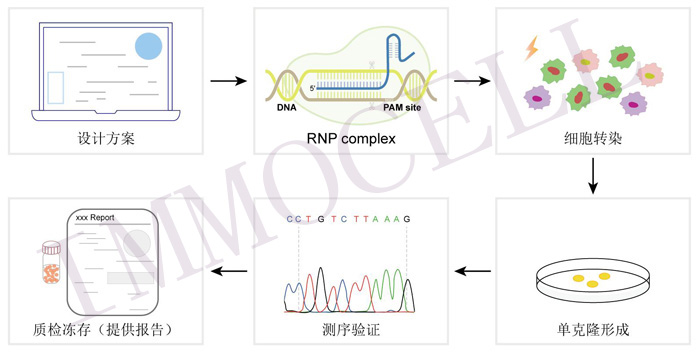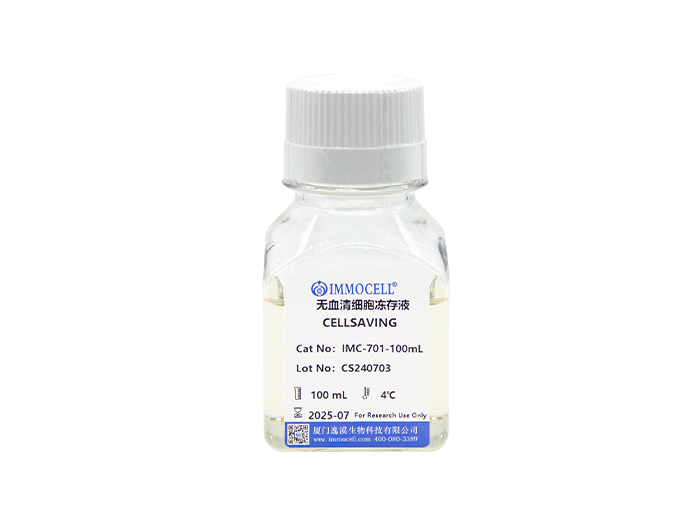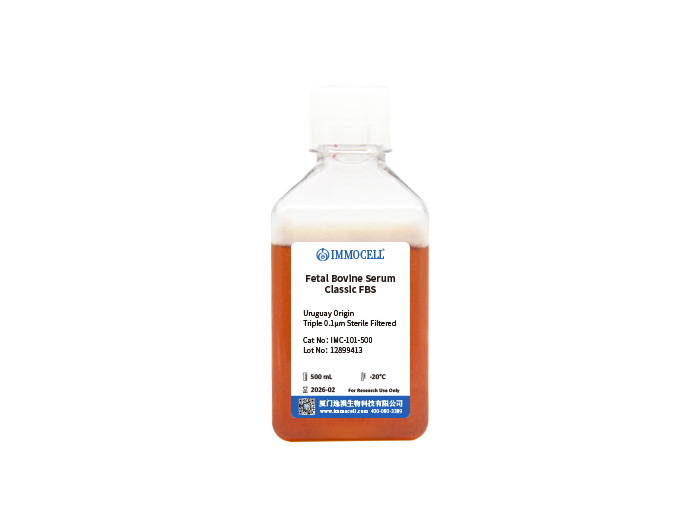| 细胞基本属性 | |||||
| 产品名称 | CERS2 knockout HeLa cell line | ||||
| 产品货号 | IMKO-H032 | ||||
| 产品规格 | 1×106cells/T25或1mL冻存管 | ||||
| 储存及运输 | 干冰运输;储存在液氮中 | ||||
| 产品分类 | 293T细胞 | ||||
| 物种 | 人 | ||||
| 修饰基因 | CERS2 | ||||
| 修饰类型 | 基因敲除 | ||||
| 转导方法 | CRISPR/Cas9 | ||||
| 克隆类型 | 纯化克隆 | ||||
| 细胞鉴定 | 通过遗传学方法确认CERS2基因敲除 | ||||
| 细胞形态 | 上皮细胞样 | ||||
| 生长特性 | 贴壁生长 | ||||
| 培养体系 | 90%MEM+10% FBS+1%PS | ||||
| 传代比例 | 1:2至1:3 | ||||
| 传代周期 | 每周3次 | ||||
| 培养条件 | 气相:95%空气+5%二氧化碳;温度:37℃ | ||||
| 冻存条件 | 无血清冻存液,液氮储存 | ||||
补充内容 | CERS2(Cholesterol ester storage disease, type 2)是一种罕见的遗传性疾病,属于胆固醇酯储存疾病的一种。这种疾病是由于CERS2基因突变导致的,它编码的是一种名为胆固醇酯储存蛋白2(Cholesterol ester storage protein 2)的蛋白质。这种蛋白质在细胞内参与胆固醇酯的代谢过程。 CERS2基因突变会导致胆固醇酯在细胞内积累,影响细胞的正常功能。这种疾病可能会导致一系列的症状,包括肝脾大、脂质代谢异常、神经系统问题等。CERS2疾病的诊断通常需要通过基因检测来确认CERS2基因的突变。目前,对于这种疾病的治疗主要是对症治疗,包括控制血脂水平、管理肝功能异常等。 | ||||
| 构建方法 |  | ||||
| CERS2基因敲除细胞系构建通常涉及的步骤 | 1.设计sgRNA:设计单链RNA(sgRNA),用于与Cas9蛋白结合,形成CRISPR-Cas9复合物,识别并切割CERS2基因的特定区域。 2.构建质粒:将设计好的sgRNA序列插入质粒载体中,通常是在质粒中包含Cas9基因,通过细胞内的转染等方式将构建好的质粒引入目标细胞。 3.细胞转染:将构建好的质粒转染到目标细胞中,使得CRISPR-Cas9复合物能够识别并切割CERS2基因的特定区域,引发基因编辑。 4.筛选纯化:通过细胞培养基中添加适当的选择性抗生素等筛选方法,筛选出成功敲除CERS2基因的细胞克隆。 5.验证敲除:通过PCR、Western blot等技术验证敲除效果,确认目标基因已经被成功敲除。 | ||||
| CERS2基因的基本信息 | Species | Gene Symbol | Gene ID | GenBank Accession | Transcript |
Human (Homo sapiens) | CERS2 | 29956 | NM_181746.4 | NP_859530.1 | |
| 关于基因 | Official Symbol | CERS2 | |||
| Previous Symbol | CERS2 | ||||
| Official Full Name | Ceramide Synthase 2 | ||||
| Synonyms | LAG1 longevity assurance Human (Homo sapiens) (Homo sapiens)log 2, LASS2, TSC4, SP260 | ||||
| Location | 1q21.3 | ||||
| Gene Type | Protein-coding | ||||
| Uniprot ID | D3DV06, Q5SZE5, Q96G23, Q9HD96, Q9NW79 | ||||
| Pathway/Library | Ceramide biosynthesis pathway | ||||
| Gene Summary | The protein encoded by this gene is a member of the TNF receptor associated factor (TRAF) protein family. TRAF proteins associate with, and mediate the signal transduction from members of the TNF receptor superfamily. This protein directly interacts with TNF receptors, and forms a heterodimeric complex with TRAF1. This protein is required for TNF-alpha-mediated activation of MAPK8/JNK and NF-kappaB. The protein complex formed by this protein and TRAF1 interacts with the inhibitor-of-apoptosis proteins (IAPs), and functions as a mediator of the anti-apoptotic signals from TNF receptors. The interaction of this protein with TRADD, a TNF receptor associated apoptotic signal transducer, ensures the recruitment of IAPs for the direct inhibition of caspase activation. BIRC2/c-IAP1, an apoptosis inhibitor possessing ubiquitin ligase activity, can unbiquitinate and induce the degradation of this protein, and thus potentiate TNF-induced apoptosis. Multiple alternatively spliced transcript variants have been found for this gene, but the biological validity of only one transcript has been determined. [provided by RefSeq, Jul 2008] | ||||
相关问题
培养指南
-
hiPSC人诱导多能干细胞培养教程:在培养hiPSC细胞前,需准备好hESC/iPSC完全培养基配制和Matrigel铺板,hiPSC人诱导多能干细胞复苏操作,1. 将水浴锅预热至37℃;并将Matrigel包被的6孔板,提前放置生物安全柜中约1小时恢复···...
阅读详情 -
H9人胚胎干细胞培养条件与方法:1. 将水浴锅预热至37℃,并将Matrigel包被的6孔板,提前放置生物安全柜中约1小时恢复至室温(15~30℃);2. 取4 mL hESC/iPSC完全培养基,按照1:4000比例加入1 μL的hESC/iPSC Supplement C,···...
阅读详情 -
H1人胚胎干细胞培养指南:在培养h1干细胞之前,首先要准备好hESC/iPSC完全培养基配制, 铺板,H1人胚胎干细胞复苏步骤:1.将水浴锅预热至37℃;并将Matrigel包被的6孔板,提前放置生物安全柜中约1小时恢复至室温(15~30℃);···...
阅读详情 -
4T1细胞培养方法:小鼠乳腺癌4T1细胞培养基 90%DMEM+10% FBS+PS,生长条件:气相:95%空气+5%二氧化碳;温度:37℃,4T1细胞形态特征为上皮细胞样,贴壁生长,如果4T1细胞密度达80%-90%,即可进行传代培养,传代方法:1:2至1:3···...
阅读详情 -
常用人肝癌细胞系有哪些及如何选择:目前较为常用的几株人肝癌细胞系SMMC-7721、Bel-7402、MHCC97、HepG2、Hep3B、Huh-7 and PLC/PRF/5,那么人肝癌细胞株如何选择呢?一方面你可以查找相关的文献,另一方面可以考虑选择···...
阅读详情 -
HL-60细胞生长慢解决方法及如何养好:当HL-60细胞传代后生长速度慢且状态不佳时,可竖着培养直到培养基变黄,待细胞密度起来后,状态会有所好转,同时,若HL-60细胞状态很差,可采用半换液的方式:以T25瓶子为例,瓶子里有5m···...
阅读详情





















